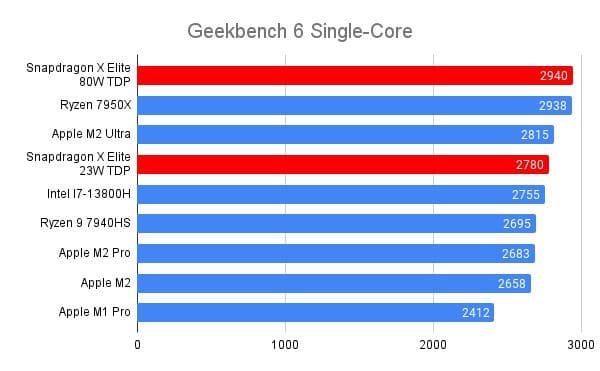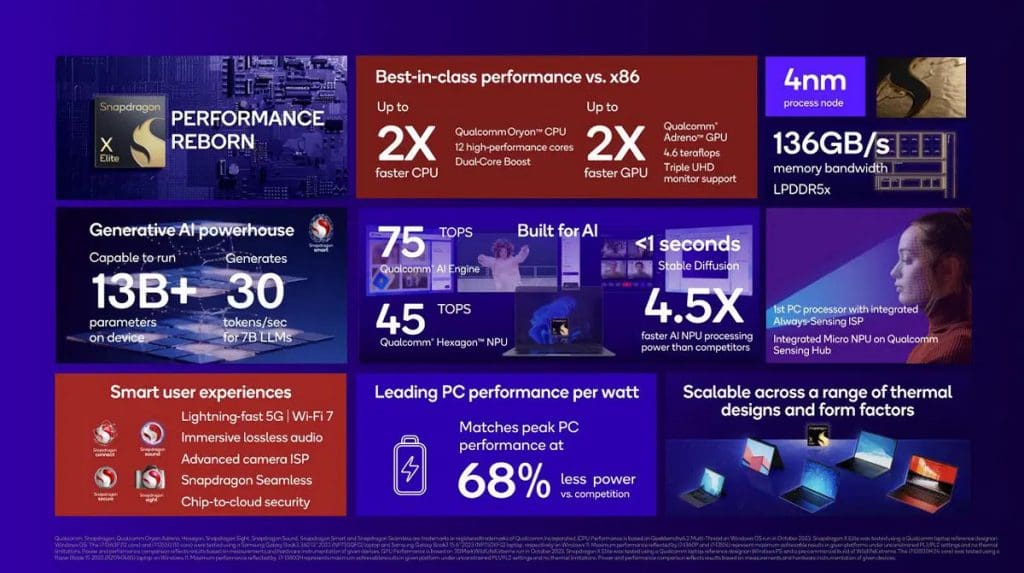The highly anticipated Snapdragon X Elite recently made its debut, while Apple swiftly unveiled its new family of M3 chipsets. Developed by the Nuvia team, a group of ex-Apple engineers acquired by Qualcomm, the Snapdragon X Elite introduces the new Oryon cores, setting the stage for a laptop segment showdown.
This comparison delves into the CPU, GPU, NPU, and more as we pit the Snapdragon X Elite against the Apple M3.
Snapdragon X Elite vs Apple M3 – Specification Comparison
| Specification | Snapdragon X Elite | Apple M3 Pro |
|---|---|---|
| Fabrication Process | TSMC’s 4nm | TSMC’s 3nm |
| Transistors | Not known | 37 Billion |
| CPU Cores | 12 cores | 12 cores |
| CPU Cluster | 12x high-performance | 6x high-performance + 6x efficiency |
| Max Frequency | 3.4GHz (23W) | Up to 4.05GHz |
| GPU | New Adreno GPU | Apple’s next-gen GPU |
| GPU Cores | Not known | 14 or 18 cores |
| TDP | 23W and 80W (two profiles) | Not known |
| Neural Engine | Hexagon NPU, 45 TOPS | Up to 16 cores |
| Unified Memory (RAM) | Up to 64GB | Up to 36GB |
| Memory Bandwidth | 136GBps | 150GBps |
| RAM Type | LPDDR5X | LPDDR5 |
| Connectivity | Wi-Fi 7 and Bluetooth 5.4 LE | Wi-Fi 6E and Bluetooth 5.3 |
| Modem | Snapdragon X65 5G modem (optional and discrete) | Exact specs not known |
| Others | AV1 encode and decode | AV1 decode |
CPU: Are Nuvia Cores Better?
Let’s kick off the comparison by scrutinizing the CPUs of the Snapdragon X Elite and Apple M3. The Snapdragon X Elite, manufactured using TSMC’s 4nm process node, boasts 12 high-performance Oryon cores and employs a tri-cluster design with varying clock speeds across different power profiles.
The 23W variant reaches a maximum clock speed of 3.4GHz, with a dual-core boost to 4.0GHz, while the 80W version goes up to 3.8GHz, with a dual-core boost to 4.3GHz. The Apple M3, built on TSMC’s 3nm process node with 37 billion transistors, also packs 12 CPU cores but is divided into 6 high-performance and 6 efficiency cores, operating at a maximum clock speed of up to 4.05GHz.
Snapdragon X Elite vs Apple M3: Geekbench 6
Geekbench 6 scores for both 23W and 80W versions of the Snapdragon X Elite have been recently revealed. The X Elite (23W) achieved 2,741 in the single-core test and 13,021 in the multi-core test, thanks to its clock speeds reaching up to 4.0GHz during single-core tasks. The X Elite (80W) obtained even better scores, with 3,238 in the single-core test and 17,181 in the multi-core test.
Comparing these results with the Apple M3, it appears that the Snapdragon X Elite has the upper hand in single-core performance. However, the multi-core performance depends on the specific core configuration, making direct comparisons challenging.

| Max Frequency | Single-core | Multi-core | Platform |
|---|---|---|---|
| Snapdragon X Elite (12-core, 12P, 23W) | 3.4GHz / 4.0GHz Dual-core Boost | 2741 | 13021 |
| Snapdragon X Elite (12-core, 12P, 80W) | 3.8GHz / 4.3GHz Dual-core Boost | 3238 | 17181 |
| Apple M3 (8-core, 4P+4E) | 4.05GHz | 3095 | 11724 |
| Apple M3 Max (16-core, 12P+4E) | 4.05GHz | 3151 | 20463 |
| Apple M2 Pro (12-core, 8P+4E, 36W) | 3.5GHz | 2643 | 14210 |
GPU: Apple or Snapdragon?
The Snapdragon X Elite integrates an Adreno GPU with unconfirmed core count, delivering 4.6 TFLOPS. On the other hand, Apple’s M3 chipset features a new GPU architecture with support for ray tracing, Mesh Shaders, and Dynamic Caching, enhancing graphics performance. While the Snapdragon X Elite surpasses the older M2’s 10-core GPU in benchmark tests, it’s likely to fall short against the M3’s more advanced GPU.
ML and AI Engine
In the realm of on-device AI capabilities, the Snapdragon X Elite takes the lead with its powerful Hexagon AI Engine, offering 45 TOPS (trillion operations per second). The Hexagon AI Engine, when combined with other components, can deliver an impressive 75 TOPS. In comparison, the Apple M3’s 16-core Neural Engine is limited to 18 TOPS. However, the M3 family offers support for larger language models with up to 128GB of Unified Memory, whereas the X Elite maxes out at 64GB.
Memory Speed
The Snapdragon X Elite employs 16-bit 8-channel LPDDR5X memory with support for up to 64GB and a memory bandwidth of 136GBps. In contrast, the Apple M3 Pro features a 192-bit memory bus, resulting in a reduced LPDDR5 memory bandwidth of 150GBps. While the M3 offers configurations of up to 128GB, it falls behind the X Elite in terms of memory speed.
Connectivity
The Snapdragon X Elite boasts Wi-Fi 7, Bluetooth 5.4, and AV1 encoding and decoding support. Additionally, it allows for a discrete Snapdragon X65 5G modem to enable always-connected PCs. The Apple M3, on the other hand, provides Wi-Fi 6E, Bluetooth 5.3, AV1 decoding, but lacks mobile connectivity.

Qualcomm vs Apple: Who’s Leading the Way?
In the CPU department, Qualcomm‘s Oryon cores appear to rival the Apple M3. However, Qualcomm needs to enhance its GPU to compete effectively in the laptop-grade chip market. To attract gamers and replace x86 as the preferred platform, Qualcomm must focus on software compatibility and work with the developer community. In terms of on-device AI, Qualcomm leads the race, setting a benchmark for AI experiences.
In conclusion, the future shines brightly for ARM, whether powered by Qualcomm or Apple.




















